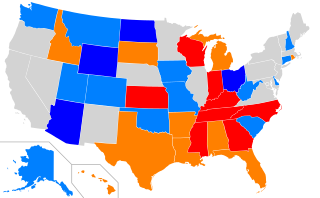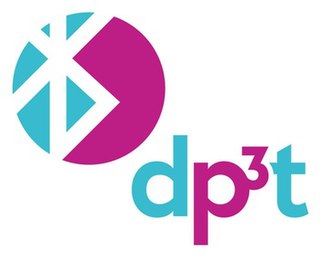
An intrusion detection system is a device or software application that monitors a network or systems for malicious activity or policy violations. Any intrusion activity or violation is typically reported either to an administrator or collected centrally using a security information and event management (SIEM) system. A SIEM system combines outputs from multiple sources and uses alarm filtering techniques to distinguish malicious activity from false alarms.
In computing, the process identifier is a number used by most operating system kernels—such as those of Unix, macOS and Windows—to uniquely identify an active process. This number may be used as a parameter in various function calls, allowing processes to be manipulated, such as adjusting the process's priority or killing it altogether.
Scanimate is an analog computer animation system developed from the late 1960s to the 1980s by Computer Image Corporation of Denver, Colorado.
Kademlia is a distributed hash table for decentralized peer-to-peer computer networks designed by Petar Maymounkov and David Mazières in 2002. It specifies the structure of the network and the exchange of information through node lookups. Kademlia nodes communicate among themselves using UDP. A virtual or overlay network is formed by the participant nodes. Each node is identified by a number or node ID. The node ID serves not only as identification, but the Kademlia algorithm uses the node ID to locate values. In fact, the node ID provides a direct map to file hashes and that node stores information on where to obtain the file or resource.
In computing, kill is a command that is used in several popular operating systems to send signals to running processes.
The chgrp command may be used by unprivileged users on Unix-like systems to change the group associated with a file system object to one of which they are a member. A file system object has 3 sets of access permissions, one set for the owner, one set for the group and one set for others. Changing the group of an object could be used to change which users can write to a file.

Solar-type star, solar analogs, and solar twins are stars that are particularly similar to the Sun. The stellar classification is a hierarchy with solar twin being most like the Sun followed by solar analog and then solar-type. Observations of these stars are important for understanding better the properties of the Sun in relation to other stars and the habitability of planets.
OBD-II PIDs are codes used to request data from a vehicle, used as a diagnostic tool.
In the x86 architecture, the CPUID instruction is a processor supplementary instruction allowing software to discover details of the processor. It was introduced by Intel in 1993 with the launch of the Pentium and SL-enhanced 486 processors.
Microsoft XML Core Services (MSXML) are set of services that allow applications written in JScript, VBScript, and Microsoft development tools to build Windows-native XML-based applications. It supports XML 1.0, DOM, SAX, an XSLT 1.0 processor, XML schema support including XSD and XDR, as well as other XML-related technologies.
In Unix and Unix-like operating systems, job control refers to control of jobs by a shell, especially interactively, where a "job" is a shell's representation for a process group. Basic job control features are the suspending, resuming, or terminating of all processes in the job/process group; more advanced features can be performed by sending signals to the job. Job control is of particular interest in Unix due to its multiprocessing, and should be distinguished from job control generally, which is frequently applied to sequential execution.
The partition type in a partition's entry in the partition table inside a master boot record (MBR) is a byte value intended to specify the file system the partition contains or to flag special access methods used to access these partitions.

Every Polish citizen 18 years of age or older residing permanently in Poland is required to have an Identity Card issued by the local Office of Civic Affairs. Children as well as Polish citizens living permanently abroad are entitled, but not required, to have one. Identity cards are valid for a period of 10 years.
The TREE-META Translator Writing System is a compiler-compiler system for context-free languages originally developed in the 1960s. Parsing statements of the metalanguage resemble augmented Backus–Naur form with embedded tree-building directives. Unparsing rules include extensive tree-scanning and code-generation constructs.
Message-ID is a unique identifier for a digital message, most commonly a globally unique identifier used in email and Usenet newsgroups.

Voter ID laws in the United States are laws that require a person to provide some form of official identification before they are permitted to register to vote, receive a ballot for an election, or to actually vote in elections in the United States.
Namespaces are a feature of the Linux kernel that partitions kernel resources such that one set of processes sees one set of resources while another set of processes sees a different set of resources. The feature works by having the same namespace for a set of resources and processes, but those namespaces refer to distinct resources. Resources may exist in multiple spaces. Examples of such resources are process IDs, hostnames, user IDs, file names, and some names associated with network access, and interprocess communication.

BlueTrace is an open-source application protocol that facilitates digital contact tracing of users to stem the spread of the COVID-19 pandemic. Initially developed by the Singaporean Government, BlueTrace powers the contact tracing for the TraceTogether app. Australia, New Zealand, and the United Arab Emirates have already adopted the protocol in their gov apps, and other countries were considering BlueTrace for adoption. A principle of the protocol is the preservation of privacy and health authority co-operation.

Decentralized Privacy-Preserving Proximity Tracing is an open protocol developed in response to the COVID-19 pandemic to facilitate digital contact tracing of infected participants. The protocol, like competing protocol Pan-European Privacy-Preserving Proximity Tracing (PEPP-PT), uses Bluetooth Low Energy to track and log encounters with other users. The protocols differ in their reporting mechanism, with PEPP-PT requiring clients to upload contact logs to a central reporting server, whereas with DP-3T, the central reporting server never has access to contact logs nor is it responsible for processing and informing clients of contact. Because contact logs are never transmitted to third parties, it has major privacy benefits over the PEPP-PT approach; however, this comes at the cost of requiring more computing power on the client side to process infection reports.
Snowflake IDs, or snowflakes, are a form of unique identifier used in distributed computing. The format was created by Twitter and is used for the IDs of tweets. The format has been adopted by other companies, including Discord, and Instagram, which uses a modified version.





